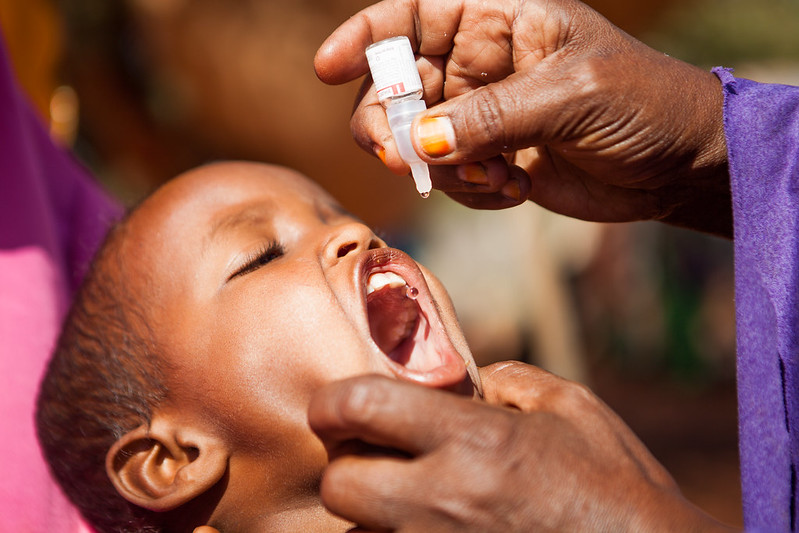Surpassing Goals: UNICEF’s Polio Vaccine in Gaza
 Polio is a serious virus that mainly affects nerves in the spinal cord or brain stem. Severe cases can lead to paralysis, trouble breathing and sometimes death. Polio can spread quickly, especially in unhygienic conditions, as it can be transmitted through contact with excrement. Most people do not show any symptoms or only contract mild flu-like symptoms that last up to 10 days. However, one in 200 infections still leads to irreversible paralysis, which can happen in a matter of hours. About 5% to 10% of those paralyzed die from paralysis of their breathing muscles. Polio mainly affects children younger than 5, but any unvaccinated person can contract it.
Polio is a serious virus that mainly affects nerves in the spinal cord or brain stem. Severe cases can lead to paralysis, trouble breathing and sometimes death. Polio can spread quickly, especially in unhygienic conditions, as it can be transmitted through contact with excrement. Most people do not show any symptoms or only contract mild flu-like symptoms that last up to 10 days. However, one in 200 infections still leads to irreversible paralysis, which can happen in a matter of hours. About 5% to 10% of those paralyzed die from paralysis of their breathing muscles. Polio mainly affects children younger than 5, but any unvaccinated person can contract it.
How Is It Back in Gaza?
Gaza recently had its first polio case in 25 years––a 10-month-old boy who is now paralyzed in his leg. Health experts have been concerned about disease outbreaks in the territory where the Israeli military has destroyed water supply and wastewater disposal networks across the territory, leaving waste to pile up in areas full of displaced people. Approximately 90% of Gaza’s 2.3 million residents have been displaced, leaving hundreds of thousands of people in crowded and unhygienic tent camps.
According to the Government Media Office in Gaza, the Israeli army has imposed control over waste dumps, targeting municipality workers, machinery and mechanisms to stop any transfer of waste away from civilian areas. According to the World Health Organization (WHO), the war has caused an interruption in routine immunization campaigns that normally prevent the virus.
UNICEF’s Polio Vaccine in Gaza
The United Nations Children’s Fund (UNICEF) has been working with the WHO and the United Nations Agency for Palestinian Refugees (UNRWA) along with the Ministry of Health in Gaza to administer the polio vaccine throughout the region in September 2024. About 2,700 workers are a part of the enclave, which started on September 1, to enter Gaza and administer the first round of the two-round vaccine. UNICEF’s original aim was for some 640,000 children ages 10 and younger to receive the type two polio vaccine or about 90% vaccination coverage. Children will need to receive two doses of the polio vaccine at four-week intervals to receive maximum protection. More than 1.2 million vaccine doses have been delivered to Gaza, with an additional 400,000 doses expected soon.
On the first day, the UNRWA reported 87,000 vaccinations were administered out of the 156,000 it was hoping to administer to that entire area. Louise Wateridge, Senior Communications Officer for UNRWA, said it was very promising to see families traveling from other regions as UNICEF and its partners are administering the vaccine one area at a time and asking when the vaccine will be available for them and their children. The polio vaccine campaign had already reached 189,000 children in Gaza as of September 4, ending the first three-day “humanitarian pause.”
More teams are being arrayed across Gaza to administer the polio vaccine. Israel has stated that it sees the importance of preventing the outbreak of polio in Gaza in order to prevent the spread of epidemics in the region. Thus, it has agreed to humanitarian pauses in three-day intervals, which would allow safe passage and access to vaccinations from 6 am to 3 pm every day.
Final Note
Around 560,000 children younger than 10 received the polio vaccine during the first round of the campaign, conducted in three phases from September 1 to 12, 2024, in Gaza. This means UNICEF has already reached its goal of administering the polio vaccine to 90% of children less than 10 in the Gaza Strip. Yet, United Nations (U.N.) officials continue to emphasize that the only way to fight against the virus effectively is through an immediate and lasting ceasefire.
– Anna Thibodeau
Anna is based in Omaha, NE, USA and focuses on Good News for The Borgen Project.
Photo: Flickr
